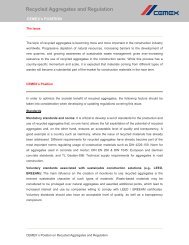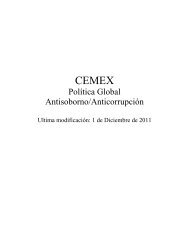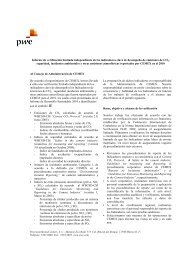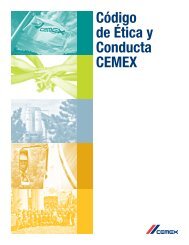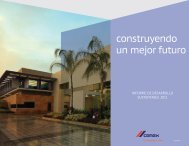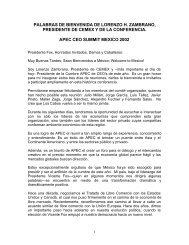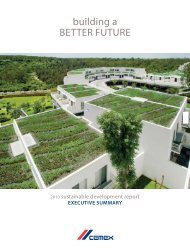building a STRONGER foundation - Cemex
building a STRONGER foundation - Cemex
building a STRONGER foundation - Cemex
You also want an ePaper? Increase the reach of your titles
YUMPU automatically turns print PDFs into web optimized ePapers that Google loves.
Low income Housing and Infrastructure. We embrace our responsibility to support social and economic progress, especially in<br />
the developing countries where we operate. We believe we can make a difference by helping support affordable housing and better,<br />
more modern and durable community infrastructure such as roads and sidewalks, schools, hospitals, parks, and other public spaces. In<br />
Mexico, for example, during 2010 close to 10 million square meters of urban and highway concrete paving were completed, and more<br />
than 1,500 houses were built with support of CEMEX Vivienda.<br />
Enhance our Carbon Strategy. Climate change poses significant challenges to our society, and we are committed to applying<br />
our skills, technologies, and determination to contribute to the development of a low-carbon economy. We have been successful in<br />
increasing fossil fuels substitution rates to 20.3% in 2010, almost double the 2008 level. We have recently introduced a new target of<br />
35% substitution rate by 2015, by far the most ambitious in our industry.<br />
Excellence in Environmental and Biodiversity Management. We are committed to mitigating the impacts that our plants,<br />
quarries, and logistics have on their surrounding communities and ecosystems. Toward this end, we have a set of global initiatives that<br />
include monitoring and controlling air emissions; managing land and conserving biodiversity within and around sites; minimizing<br />
disturbances such as noise, vibration, and traffic; optimizing water use; and reducing and recycling waste. Overall, we have quarry<br />
rehabilitation plans in place at 85% of our active cement and aggregates sites, and we are on track to achieve our target of 100% by<br />
2015. We continued our successful partnership with BirdLife International in 2010 and completed a multi-year, comprehensive<br />
scoping study on the biodiversity status of CEMEX’s operations worldwide to facilitate a process that aims to enhance biodiversity<br />
conservation throughout our operations. The study mapped 543 sites and assessed their proximity to areas of high biodiversity value.<br />
In the 131 sites that overlap with areas of high biodiversity value we will implement biodiversity action plans within the next five<br />
years.<br />
Strengthen Local Communities. By engaging in ongoing dialogue, we understand the needs and concerns of the communities in<br />
which we operate. We then leverage our core business strengths, including our institutional knowledge and experience, our<br />
employees’ talent and time, and our social investments, to support the social and economic development of those communities.<br />
Specifically, we contribute to disaster relief; promote employee volunteering; foster local environmental awareness; and support<br />
educational, cultural, and sports activities. In September 2010, the United Nations recognized CEMEX for its contributions towards<br />
achieving the Millennium Development Goals. Among the community development programs for which CEMEX is being recognized<br />
is Centros Productivos de Autoempleo, an initiative that establishes community centers where low-income families can produce basic<br />
<strong>building</strong> materials for the construction or expansion of their homes. By 2010, Patrimonio Hoy, our flagship low-income housing<br />
support program, with presence in five countries (Mexico, Colombia, Nicaragua, Costa Rica and the Dominican Republic), has<br />
assisted more than 300,000 families to improve their housing conditions.<br />
Partnership with Key Stakeholders. We continuously interact with a wide variety of stakeholders to discuss and address<br />
society’s most pressing needs. Within our sustainability model, we have defined four core stakeholder groups: our people, our<br />
neighbors, our business partners, and our world. Beyond this, we actively engage with our sustainability reporting advisory panel, a<br />
group of leading experts, who provide important and valuable advice.<br />
High Priority to Health and Safety. The safety, health, and well-being of our employees, contractors, and third parties affected<br />
by our operations are our highest priority. That is why we have introduced industry-leading safety systems to identify and address<br />
risks, implemented innovative employee health initiatives to promote well-being, and instituted line-manager ownership of health and<br />
safety to ensure that programs are implemented and led as effectively as possible.<br />
Global Safety Leadership Training: In 2009, we developed LEGACY, a two-day safety leadership program, which<br />
provides our managers around the world with the tools and skills they need to promote safer operations. As of<br />
December 31, 2010, we had trained more than 2,100 supervisors and managers and had 140 employees who served as<br />
LEGACY trainers.<br />
Driving and Contractor Safety: We participate in the Cement Sustainability Initiative and measure our compliance with<br />
best practices in driving and contractor safety to reduce fatal injuries from road traffic incidents, one of the leading causes<br />
of fatalities within our industry. During 2010, we set a performance baseline and established a five-year plan of preventive<br />
action that focuses on achieving 100% compliance with Cement Sustainability Initiative recommended practices for our<br />
driving safety performance and the performance of high-risk contractors throughout our operations. In 2010, 98% of our<br />
operations had local safety training programs for drivers, compared with 97% in 2009 and 81% in 2008.<br />
Health Management: During 2010, we increased the percentage of our operations that have implemented a local health<br />
management system to 79%, from 76% in 2009 and 52% in 2008. To complement these systems, we developed our global<br />
Health Essentials campaign, which provides managers in all business units with practical and easy-to-use materials on 12<br />
key topics including heart and back health, stress management and nutrition. In 2010, approximately 54% of our<br />
employees participated in annual medical exam programs.<br />
32



